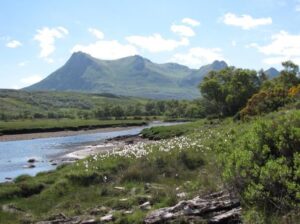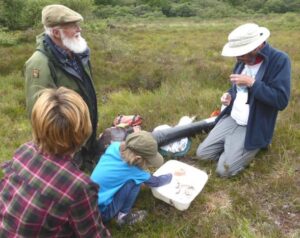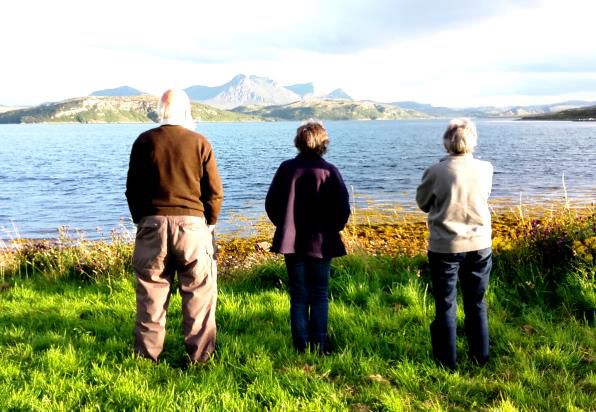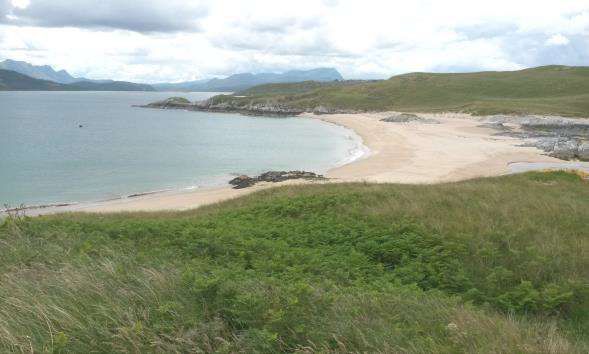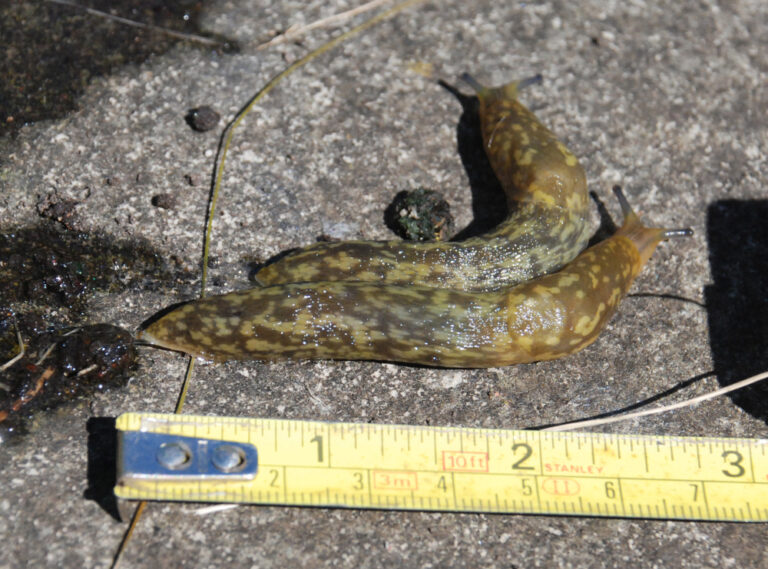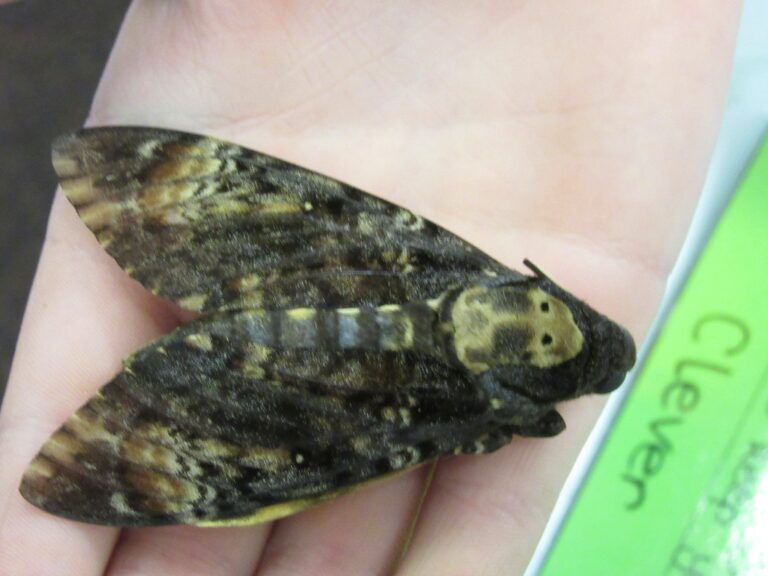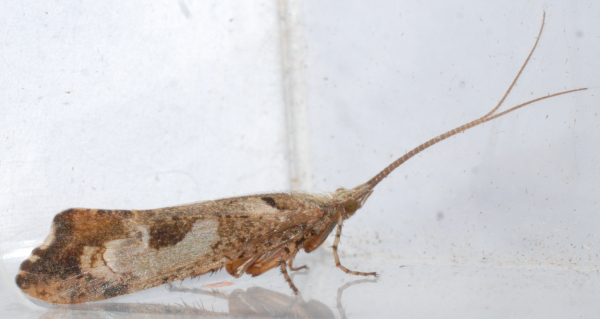Source with permission: The Highland Naturalist – Number 14 – April 2018
AROUND AND ABOUT: Tongue: a proposed wildlife audit
by Ian M. Evans
Introduction
The Sutherland Biodiversity Action Plan (2003) includes a section on ‘Town and Village’, but those involved in its preparation found that there was little or no information available on the biodiversity of any of the towns or villages of Sutherland. In 2005 the Sutherland Biodiversity Group sponsored Village Wildlife Audits of two settlements in the county, Scourie in the west and Rogart in the east, accounts of which were later published (Scourie Wildlife Group, 2006; Rogart Wildlife Group, 2007).
Members of the Biodiversity Group have long been conscious of the lack of an audit for any settlement on the north coast. Recent events suggest that the parish of Tongue would be a good candidate. This article charts progress so far and invites the participation of members of the Highland biological recording community.
The setting
Tongue, with an area of 132 sq.miles (352 sq.km), is the smallest of five parishes that make up the vice-county of West Sutherland (vc.108). It lies about a third of the way along the north coast of Scotland, on either side of the Kyle of Tongue, into which flows the Kinloch River. Its boundaries run south from the cliffs east of Whiten Head and then along the water divide west of the Kyle, the western edge of the catchment of the Kinloch River south to Loch Meadie, the eastern edge of the catchment of the River Borgie, the eastern shore of Loch Loyal and then further parts of the catchment of the River Borgie north to the shores of Torrisdale Bay (Figure 1).
These boundaries encompass the greater part of five 10km squares: NC54, 55, 56, 65 and 66 and the north-western corner of NC64.
The whole of Ben Loyal lies within the parish, as do Ben Hutig, Meallan Liath (on the eastern flanks of Ben Hope) and parts of Beinn Stumanadh. The larger bodies of freshwater are Loch an Dherue, Loch Meadie, Loch Loyal and Loch Craggie, but there are numerous smaller ones. There are three sets of offshore islands, the Rabbit Islands, Eilean nan Ron and Neave Island.
Present-day human settlements are located in three main clusters: Melness and associated crofting townships west of the mouth of the Kyle; Tongue village, with Coldbackie and Skullomie, on its eastern edge; Skerray and associated crofting townships between the Kyle and the River Borgie.
Much of the land in the west and south of the parish is now owned by the Danish businessman Anders Povlsen (Wildland Ltd), elsewhere by Sutherland Estates, other private owners and crofting communities.
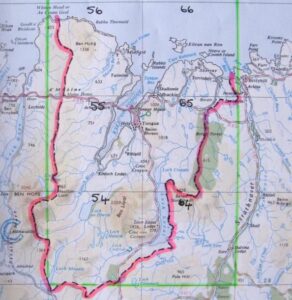
History of wildlife recording
The earliest records from the parish are predictably botanical, dating back to James Robertson’s travels in 1767. John Anthony’s Flora of Sutherland (Kenworthy, 1976) provides a summary of the records for some 540 species of higher plants, including, for example, 16 species of orchids. At about the time this Flora was published, R.E.C. Ferreira was starting his comprehensive vegetation survey of hitherto undesignated sites in West Sutherland (Ferreira, 1995), which includes some 70 sites situated wholly or partly within the parish. Many lie within the local part of the suite of SSSIs known collectively as the Caithness and Sutherland Peatlands.
More recently, botanists Pat and Ian Evans from Assynt and Ken and Sheila Butler from Thurso, amongst others, have surveyed specific areas, mainly on the coast, as contributions to the BSBI Atlas (2002) and to Site Condition Monitoring of the former Invernaver NNR (2003).
Vertebrate records from Tongue in the 19th century are to be found in works such as A fauna of Sutherland, Caithness and West Cromarty (Harvie-Brown and Buckley, 1887). There appear to be few published faunal records from the 20th century, other than a brief account of the vertebrates in Jim Johnston’s guidebook to Tongue and Farr (Johnston, 1981).
However, the parish has had resident naturalists, such as Peter Burr of Tongue and Alan and Irene Joyce of Achininver (the last, happily, still with us), and is frequently visited by others. There was a wildlife survey of the Skerray area in 2003, sponsored by the Sutherland Biodiversity Group, and the interests of local naturalists currently include bird ringing, the diet of barn owls, butterflies and moths, flies and whales.
Much unpublished information on aspects of Tongue wildlife over the last few decades has already been located, relating to groups such as fungi, lichens, bryophytes, ants and bumblebees, other insects, other arthropods, molluscs, freshwater and marine life, but it requires collating and evaluating.
Recent events
Following Pat’s death early in 2015, Ian became BSBI Vice-county Recorder for West Sutherland. In 2016 he began systematic surveys of selected 1km squares in the area for the projected BSBI Atlas (2020), aided by Assynt naturalist Gwen Richards. This work has been based in self-catering accommodation at Rhitongue, where they have been joined on occasion by other members of the HBRG, including Stephen Moran, Gordon P. Rothero and Ro Scott.
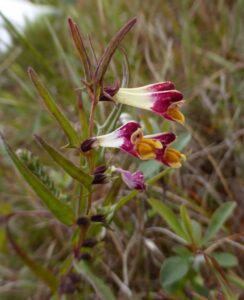
Memorable visits during 2016 included one to the Rabbit Islands on 13th July (see THN 13, 15-18), Beinn Stumanadh (GPR and RS, 12th July) and Ben Loyal (GPR, GR and RS, 14th July), but the three weeks survey work also covered sites at Castle Varrich (Figure 2), Dalcharn, Inchkinloch, Kinloch (Figure 3), Lettermore (on Loch Loyal), Talmine and the mouth of the River Borgie. Although the recording is primarily botanical, any animal life seen is logged.
During that year the Tongue area began to cast its spell (a well-known phenomenon). During the following winter various individuals began to discuss the possibility of a more structured attempt to document the undoubted wildlife attractions of the parish. A meeting of interested parties, local and from further afield, was hosted by Abby and Gary Rhodes at Strathtongue on 1st March 2017 and on 10th May the Tongue, Melness and Skerray Wildlife Group was formally constituted.
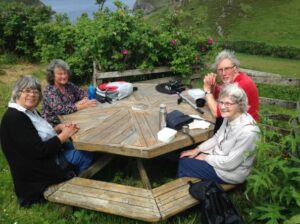
Through the kind offices of Andy Summers, Chair of the Assynt Field Club, a successful grant application (to the value of £4337) was made to the Caithness and North Sutherland Fund. This will help with the purchase of equipment such as maps, hand lenses, g.p.s., trail cameras and a bat detector, the expenses of visiting experts and events, and a booklet (see below).
The group had three field meetings coinciding with botanical survey visits in June, July and August, which drew upon the expertise of HBRG members.
On 21st June, fourteen locals and visitors (Figure 4) enjoyed a ‘Wildflower Wander’ on Gavin and Kay Lockhart’s croft at Lamigo (NC6563), of which the highlight was a stand of globeflower Trollius europaeus). The leaders, Ian and Gwen, returned two days later to make a more leisurely listing of the plants on the route and down to Lamigo Bay, logging 155 species, including a splendid stand of greater butterfly-orchid Platanthera chlorantha in a hayfield just above the Bay (Figure 5).
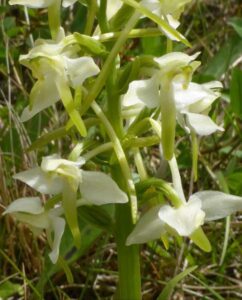
On 12 July, Stephen Moran led a smaller group of six, including six-year old enthusiast Connie Gordon and her mother (Figure 6), on a ‘Creepy Crawly Walk’ along the footpath from Tongue village towards Castle Varrich (NC5856). This skirts flower-rich fields on the Gordon family croft (Figure 7) and an impressive range of insects was recorded there and across a backwater of the Kyle.
Stephen was so taken with the area that he returned the next day to supplement the list. On the way, he dropped into one of the policy woodlands between Rhitongue and the village to beat some larch and came back hotfoot with a picture of an orchid on his smartphone. This proved to be part of a large stand of creeping lady’s-tresses Goodyera repens, first recorded in the vicinity (without a precise locality) in 1897 and once again in 1958 (Figure 8).
On 16th August, a party of twenty-two, including two families of visitors, gathered on a small beach at Midfield (NC5765) for a session of ‘Strandline Shell Collecting’ led by Ian, Gwen and Ro (Figure 9). Although searching was curtailed after about an hour by the onset of drizzle and midges, a good range of species was found, including some impressive specimens of colourful small scallops (which the finders could not be persuaded to hand over, even in the interests of science).
The leaders spent the afternoon recording the plants at the beach and around the mouth of the Strath Melness Burn, which is in the same 1km square. The 140 species noted included goat’s-beard Tragopogon pratensis in dunes, several stands of Scottish primrose Primula scotica and, unusually, royal fern Osmunda regalis on a sea-cliff.
The most memorable days botanising in the parish during 2017 was on 17 August, which four of us spent in remote country south of Kinloch, reported on elsewhere in this journal. However, we also recorded sites at Airdtorrisdale, A’Mhoine, Ardachaidh (eastern shore of the Kyle), Strathan Skerray and north of Talmine.
Future
The Committee of the Wildlife Group has organised a series of winter meetings and is arranging a full programme of summer activities, to which members of HBRG will be contributing. A joint meeting with HBRG is provisionally scheduled for Saturday 21st July.
The Group has a Facebook page (https://www.facebook.com/groups/northsutherlandwg) set up by Stephen Kirkup of Skerray, on which notices and reports of events and observations are posted. The geographical scope of this page has been enlarged to include most of north Sutherland.
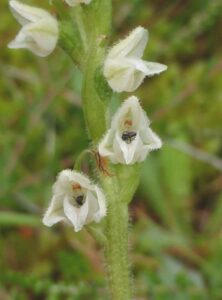
Project funding from the CNS Fund lasts for the two years to 1st April 2019. Apart from activities and information gathering, one of its specific objectives is to produce a booklet for visitors on accessible places to see wildlife in the vicinity of Tongue and this is in preparation. A longer term aim is a more substantial account of the wildlife audit of the parish, which it is hoped to publish independently.
Ian, Gwen, Ro and others are planning a further three weeks botanical and other survey work from the Rhitongue base in June and July 2018 (Figure 10). Meanwhile, may we please ask any members of HBRG who have knowledge of the area, or are perhaps planning to visit it, to get in touch with Ian (ian.evans.nedd@gmail.com).
It is fashionable to refer to the sort of activities in which we are engaged at Tongue as ‘citizen science’. I prefer to look upon them as a tribute to the joys of wonder, discovery and communication in a landscape of great age and surpassing beauty.

